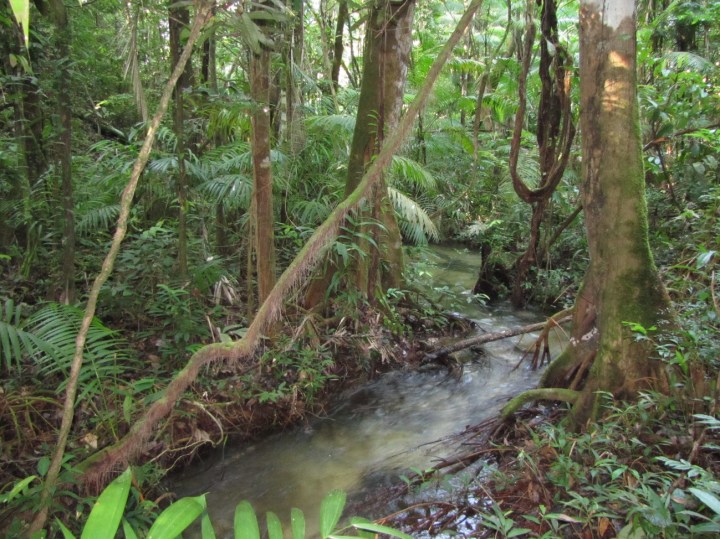Looking beyond the trees in tropical forest landscapes, Cecília Leal comments on recent article, Is environmental legislation conserving tropical stream faunas? A large-scale assessment of local, riparian and catchment-scale influences on Amazonian fish.
What comes to your mind when you think about the Amazon River Basin? Large rivers, giant fish, impacts from big hydroelectric projects? Our new article in Journal of Applied Ecology calls attention to the incredible diversity of fishes found in Amazonian small streams. And highlights how they are not sufficiently protected by current environmental legislation.
It’s well known that the Amazon is a megadiverse biome of global relevance. However when we start putting numbers on that it becomes really striking. In our study we found more fish species in a single small stream, 3 m wide, than in whole countries such as Norway or Denmark. Even more surprising is the fact that many such streams were not found in pristine forest landscapes, but in rural areas of Paragominas, eastern Brazilian Amazon, a municipality of 100 thousand people with well-developed agriculture.

In total, we studied 83 small streams in three Amazonian river basins. Not only did we find a high diversity of fish, but also that streams share few species, even within the same river basin. Moreover we found species that are new to science and many rare species, occurring in few streams and/or in low number of individuals.
With this in mind we examined the effectiveness of the current Brazilian legislation in protecting such diverse ecosystems, and discuss the implications of our results for large-scale conservation planning in human-modified tropical forest landscapes more generally.
How is Brazil aiming to protect its streams? Is it working?
Holding 60% of the Amazon Basin, Brazil has a huge responsibility in reconciling biodiversity conservation and agricultural expansion. Its environmental regulations seek to protect freshwater ecosystems in two main ways: establishing protected areas and controlling forest cover on private properties.
The fact that Amazonian streams in the forest-agriculture landscapes are highly diverse and heterogeneous makes it clear that no single area can be representative of the regional fauna. For instance the Tapajós National Forest (FLONA Tapajós, acronym in Portuguese), a protected area within our study area, did not host many species from the regional pool. This doesn’t mean that FLONA Tapajós or other public reserves are not vitally important, but that they alone cannot safeguard Amazonian stream fauna from human impacts. Therefore it is essential that conservation measures also take place on private lands.

Beyond public protected areas, private properties make up about half of the Brazilian Amazon. The most important environmental legislation in those lands is the Brazilian Forest Code. Although the Forest Code stipulates a minimum width for riparian forests and limits deforestation outside riparian zones, it does not provide guidance for forest protection at catchment or basin scales, or for agricultural practices, both of which affect the freshwater biota. We show that fish respond mainly to changes in the local instream habitat (e.g. substrate type, channel morphology, dead wood) that in turn reflect not only what happens at the riparian zone but in other areas of the catchment. For instance, there is a whole suite of drivers of the instream habitat such as road crossings and mechanised agriculture that are only indirectly linked to variables more frequently addressed by the legislation. Therefore the Forest Code’s focus on the riparian zone whilst important, offers only limited protection to Amazonian streams and should not undermine the necessity to maintain and restore forest cover elsewhere in the catchment.

Implications for the conservation of streams in the world’s largest tropical forest
Our results have important implications for the implementation of the Forest Code in the Brazilian Amazon. Presently, the law allows a deforested area in a given property to be compensated by forest areas anywhere in the biome, i.e. thousands of kilometres away. But we highlight the importance of local compliance efforts, either by focusing on restoration in landscapes that are heavily deforested or by undertaking off-farm compensation within the same river basin. Moreover the focus of the Forest Code on riparian forest patches should not undermine the need to maintain and restore native vegetation in areas further away from the streams.
To safeguard the species-rich freshwater biota of small Amazonian streams, conservation actions must therefore shift towards managing whole basins and drainage networks, as well as agricultural practices in already cleared land.
The full article, Is environmental legislation conserving tropical stream faunas? A large-scale assessment of local, riparian and catchment-scale influences on Amazonian fish is available in Journal of Applied Ecology.

One thought on “Is environmental legislation conserving tropical stream faunas?”